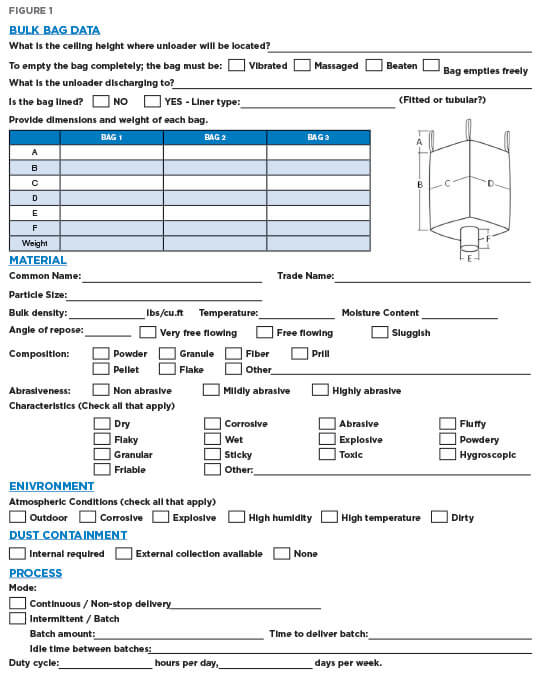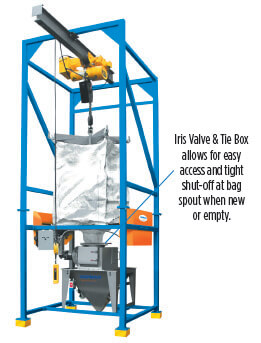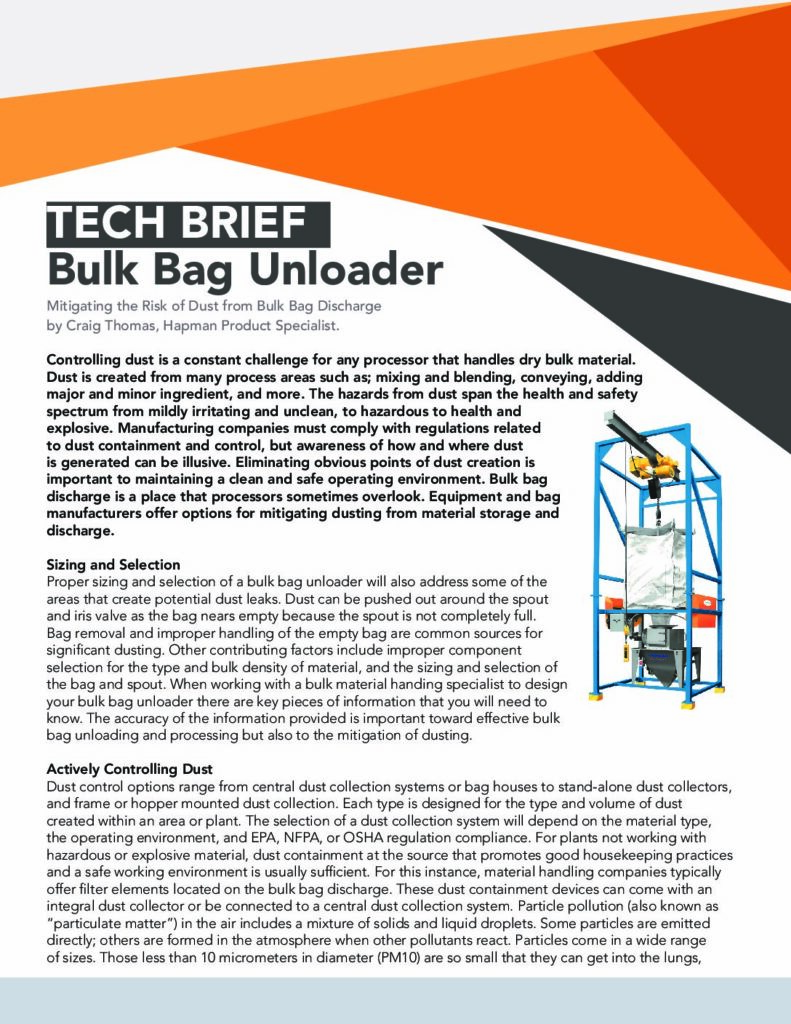
CHALLENGE
Controlling dust is a constant challenge for any processor that handles dry bulk material. The hazards from dust span the health and safety spectrum from mildly irritating and unclean, to hazardous to health and explosive.
Controlling dust is a constant challenge for any processor that handles dry bulk material. Dust is created from many process areas such as; mixing and blending, conveying, adding major and minor ingredient, and more. The hazards from dust span the health and safety spectrum from mildly irritating and unclean, to hazardous to health and explosive. “In terms of air quality, OSHA wants clean air inside for employees, and the EPA wants clean air outside for the public,” states Patrick Ostrenga of OSHA. (http://www.plantservices.com/articles/2012/09-dust-collectionsystemssmaller-greener-safer/) Manufacturing companies must comply with regulations related to dust containment and control, but awareness of how and where dust is generated can be illusive. Eliminating obvious points of dust creation is important to maintaining a clean and safe operating environment. Bulk bag discharge is a place that processors sometimes overlook. Equipment and bag manufacturers offer options for mitigating dusting from material storage and discharge.
Sizing and Selection
Proper sizing and selection of a bulk bag unloader will also address some of the areas that create potential dust leaks. Dust can be pushed out around the spout and iris valve as the bag nears empty because the spout is not completely full. Bag removal and improper handling of the empty bag are common sources for significant dusting. Other contributing factors include improper component selection for the type and bulk density of material, and the sizing and selection of the bag and spout. When working with a bulk material handing specialist to design your bulk bag unloader there are key pieces of information that you will need to know. The accuracy of the information provided is important toward effective bulk bag unloading and processing but also to the mitigation of dusting. Information that is key to proper sizing of an unloader is shown in Figure 1 (below).

Dust control options range from central dust collection systems or bag houses to stand-alone dust collectors, and frame or hopper mounted dust collection. Each type is designed for the type and volume of dust created within an area or plant. The selection of a dust collection system will depend on the material type, the operating environment, and EPA, NFPA, or OSHA regulation compliance. For plants not working with hazardous or explosive material, dust containment at the source that promotes good housekeeping practices and a safe working environment is usually sufficient. For this instance, material handling companies typically offer filter elements located on the bulk bag discharge. These dust containment devices can come with an integral dust collector or be connected to a central dust collection system. Particle pollution (also known as “particulate matter”) in the air includes a mixture of solids and liquid droplets. Some particles are emitted directly; others are formed in the atmosphere when other pollutants react. Particles come in a wide range of sizes. Those less than 10 micrometers in diameter (PM10) are so small that they can get into the lungs, potentially causing serious health problems. Ten micrometers is smaller than the width of a single human hair. (http://cfpub.epa.gov/airnow/index. cfm?action=aqibasics.particle)
 The dust collection on a Bulk Bag Unloader simply does not allow the dust to leave the bag during start up or bag change. The unloading system with integral dust containment, provides an operator access to the bag spout in a contained untie box, a positive flow shut-off valve allows the operator to untie the bag without an instantaneous load of dry material discharging from the FIBC at once. Once the operator has the untied bag spout, the valve is manually opened slowly at varying intervals until full-open. This same process is performed in reverse when the bag is empty. Significant dusting can occur when the bag is empty if operators fail to account for the residual material left in the bag at empty. Without dust containment, the bag spout on an empty bulk bag is typically left open. Dust can be created when the bag is removed from the unloader and amplified when the bag is compressed for recycle or disposal.
The dust collection on a Bulk Bag Unloader simply does not allow the dust to leave the bag during start up or bag change. The unloading system with integral dust containment, provides an operator access to the bag spout in a contained untie box, a positive flow shut-off valve allows the operator to untie the bag without an instantaneous load of dry material discharging from the FIBC at once. Once the operator has the untied bag spout, the valve is manually opened slowly at varying intervals until full-open. This same process is performed in reverse when the bag is empty. Significant dusting can occur when the bag is empty if operators fail to account for the residual material left in the bag at empty. Without dust containment, the bag spout on an empty bulk bag is typically left open. Dust can be created when the bag is removed from the unloader and amplified when the bag is compressed for recycle or disposal.
Dust control at a bulk material discharge source, can reduce the size and requirements needed in central dust collection systems or may eliminate the need for a central system all together. These systems can range from cartridge filtration to cyclone dust collectors, to bag house collection. For a bulk bag unloader options exist for standalone units or integral as described above, while both are effective for controlling dust at the source, the integral system is often less expensive and requires no added floor space to operate.
Summary
Eliminating dust in bulk material handling operations is a constant challenge for processors. One option for maintaining environmental and safety compliance as well as general housekeeping is to consider controlling dust at the source. Controlling dust at the source and working either independently or in conjunction with a central dust collection system can help ensure compliance while keeping workers safe. In the case of a bulk bag unloader, evaluating options for dust containment range from integral to stand-alone, with the integral option needing no additional floor space. The best selection should be made by working in conjunction with an experienced material handling equipment manufacturer.
